![]()
German Immigration in Victoria in the 19th Century - Overview
In the first half of the nineteenth century a few individual Germans arrived in Port Phillip (as Victoria was then known), for example a gentleman named Von Bibra, who was a descendant of an old Bavarian noble family. He went across to Victoria from Launceston in Tasmania in September 1835. The Irish-German brothers Von Steiglitz, who owned large properties in Tasmania, moved from there to Victoria in June of 1836.
The first significant immigration began in 1849 when the first large groups of immigrants arrived in ships from Hamburg. At the time there was a shortage of agricultural workers in Victoria, and in addition, people who wished to establish vineyards were not able to get skilled vine workers from Britain. Leading figures in Melbourne saw how successful the immigration of Germans in South Australia was, and were keen to encourage immigrants to come from Germany to Victoria. An editorial in the Port Phillip Gazette early in December 1846 stated:
|
A healthy, useful, and moral emigration has been taking
place during the last five years between Germany and South Australia.
Our Adelaide contemporaries speak in the highest terms of their German
colonists (...) We do not envy our neighbours their good fortune in possessing
such a useful class of Colonists; but we think that, if possible, this
District ought to take some steps to obtain a supply from the German Ports.
(...) Port Phillip possesses many agricultural Districts, which would
be eminently fitted to receive these hard-working emigrants.
|
William Westgarth, a successful Melbourne businessman, was the leading figure in organising German immigration to Victoria, and he was the convenor of the German Immigration Committee formed in 1849. The Hamburg shipping firm of J.C. Goddefroy and Son and the Bremen emigration agent Eduard Delius organised the journey itself. The Colonial Land Fund was supposed to pay the fares, as long as the immigrants were all agricultural workers. This caused some controversy later when it turned out that very few of the immigrants on the first ship fulfilled this criterion.
The first ships to arrive were:
| the Goddefroy, on 13th February 1849, from which 117 immigrants disembarked (42 sailed on to Adelaide) | |
 |
the Wappaus, on 7th March, 131 adults |
| the Dockenhuden, on 21st April, 99 passengers (all of whom could read and write; at the time people noted that this was the case with most German immigrants, in contrast to the average British immigrant) | |
| the Emmy, on 19th December |
Most of the immigrants were Lutheran and from the north of Germany, mainly from Prussia (many from the province of Silesia) and Saxony. Most of them came in family groups, and a considerable number were Wends, who were bilingual Wendish/German.
Some of the German immigrants went to Geelong (there was a "Geelong Committee on German Immigration") and in the summer of 1849-50 eight families (farmers from Züllichau in the Prussian province of Brandenburg) established a settlement named Germantown close to Geelong. During the First World War the name Germantown was changed to Grovedale, which is today a suburb of Geelong.
Lutheran church services started on Christmas Day 1849 in the Independent Church in Collins Street. In 1853 Pastor Matthias Goethe became Melbourne's first permanent Lutheran minister, and the first Lutheran church in Melbourne was built in 1854. Today's Lutheran church was built in 1874.
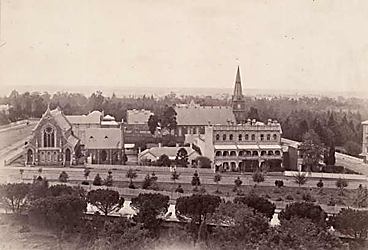
"View of East Melbourne, including the German Lutheran Church", 1874
(left side)
(La Trobe Picture Collection, State Library of Victoria)
The German immigrants introduced the German tradition of the Christmas tree to Australia. Theodor Müller, who became the poet of Victoria's German community, later described in a magazine in Germany how the Melbourne German Association (Deutscher Verein) put up "the first German Christmas tree under the skies of the Southern Cross" at Christmas time in 1850 for the enjoyment of the children of the city. This tradition became popular with the British colonists.
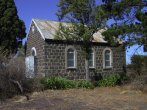 In
March 1850 a group of German and Wendish farmers from Mecklenburg, Sachsen and
Schlesien established the Westgarthtown settlement
16 km north of Melbourne with the help of William Westgarth. Over time this
village was known by various names: in 1850 as Keelbundora (after the parish
in which it was located); ~1851 Dry Creek; ~1855 New Mecklenburg; ~1860 Westgarthtown;
since about 1900 it has been part of the suburb Thomastown.
In
March 1850 a group of German and Wendish farmers from Mecklenburg, Sachsen and
Schlesien established the Westgarthtown settlement
16 km north of Melbourne with the help of William Westgarth. Over time this
village was known by various names: in 1850 as Keelbundora (after the parish
in which it was located); ~1851 Dry Creek; ~1855 New Mecklenburg; ~1860 Westgarthtown;
since about 1900 it has been part of the suburb Thomastown.
Several small enclaves of Germans arose in different parts of Melbourne, eg Hawthorn, Richmond, Collingwood, Boroondara and Northcote (many lived in Separation Street; the old cemetery in that street has many graves inscribed in German, but it's unfortunately not being maintained very well). In these areas the Germans of course lived among the British. Further out from the city centre, German communities were founded at Harkaway (near Berwick) and at present-day Doncaster (at first it was known as Breslau and later as Waldau - see a List of German placenames in Australia).
The discovery of gold in Victoria in 1851 brought thousands of German-speaking adventurers and immigrants to the colony. German miners in Victoria were the largest ethnic group after the British and the Chinese. A leading figure in the Eureka Stockade, the tragic miners' rebellion at Ballarat, was the Hannoverian Friedrich Wern. After the search for gold many German-speaking immigrants stayed and contributed much to Victoria and Australia. About 14 German Associations (Deutscher Verein) were established in regional areas.
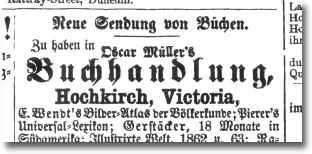 In
1852 German-speaking Sorbs/Wends from the Barossa Valley seeking better and
more land moved into the Western District of Victoria, having heard reports
of good land available there for them. They moved to the area around today's
Hamilton and were finally able to establish several German-speaking settlements
such as Hochkirch (now Tarrington) and Gnadental ("Valley of Grace"), near Penshurst
(1853). Hochkirch was named after the Lusatian town of Hochkirch in Saxony (south-eastern
Germany) near which most of the Sorbian/Wendish settlers had been born. At first
they called the settlement Bukecy; Hochkirch is the German-language form of
the Sorbian name Bukecy. By 1869 Hochkirch had a population of 850, with a school,
a library and a newspaper office, all of them run in German. Among the early
settler families were the Hufs, Petschels and Mibus's
(Hochkirch), and the Bürgers and Mirtschins (Gnadenthal).
Oscar Mueller's newspaper office was also a major printing business, and printed
many publications for the Lutheran church in South Australia and Victoria. Mueller
advertised in Melbourne's German newspapers too (this example from "Germania",
26/3/1864).
In
1852 German-speaking Sorbs/Wends from the Barossa Valley seeking better and
more land moved into the Western District of Victoria, having heard reports
of good land available there for them. They moved to the area around today's
Hamilton and were finally able to establish several German-speaking settlements
such as Hochkirch (now Tarrington) and Gnadental ("Valley of Grace"), near Penshurst
(1853). Hochkirch was named after the Lusatian town of Hochkirch in Saxony (south-eastern
Germany) near which most of the Sorbian/Wendish settlers had been born. At first
they called the settlement Bukecy; Hochkirch is the German-language form of
the Sorbian name Bukecy. By 1869 Hochkirch had a population of 850, with a school,
a library and a newspaper office, all of them run in German. Among the early
settler families were the Hufs, Petschels and Mibus's
(Hochkirch), and the Bürgers and Mirtschins (Gnadenthal).
Oscar Mueller's newspaper office was also a major printing business, and printed
many publications for the Lutheran church in South Australia and Victoria. Mueller
advertised in Melbourne's German newspapers too (this example from "Germania",
26/3/1864).
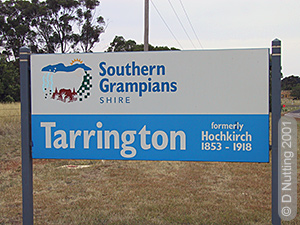
|
"Wanted, a German girl |
In the 1850s and 1860s a considerable number of Germans were leading figures in Melbourne's scientific and artistic organisations, for example the botanist Baron Ferdinand von Mueller, the zoologist Gerhard Krefft, the astronomer Georg von Neumayer, and the artists Eugen von Guérard and Ludwig Becker, to name just a few. Germans played a significant role in Victoria's tragic Burke & Wills expedition. |
The Moravian Brethren, a missionary group based in Saxony, ran mission stations among Victoria's Aboriginals, for example the Ebenezer mission in the Wimmera (1859-1904), and the Ramahyuck mission at Lake Wellington in Gippsland, founded in 1862.
In the 1860s German farmers from Victoria's Western District and from South Australia started colonising the southern Wimmera region. Many villages developed, some with German names (Kirchheim, Grünwald, Kornheim), some with Aboriginal names. These German settlers made a big contribution to the development of the wheat industry in the Wimmera.
 In
the 1880s and 1890s Germans moved onto land in the Mallee region in the northwest
of Victoria and established settlements like Rainbow and Pella.
Farming for these families in the Mallee was extremely hard work due to the
nature of the ground. Nevertheless, most of these German families have stayed
in the area. In Ian Maroske's book The Story of Pella (1975) he wrote:
"For its first fifty years, Pella was a place of many families, many children,
much hard work, little luxury and much happiness."
In
the 1880s and 1890s Germans moved onto land in the Mallee region in the northwest
of Victoria and established settlements like Rainbow and Pella.
Farming for these families in the Mallee was extremely hard work due to the
nature of the ground. Nevertheless, most of these German families have stayed
in the area. In Ian Maroske's book The Story of Pella (1975) he wrote:
"For its first fifty years, Pella was a place of many families, many children,
much hard work, little luxury and much happiness."
Unlike in South Australia, German pastors were not involved (or available) in the establishment of German settlements. This meant that settlements were not developed together in one area, but arose in different areas, so that Victoria has no particularly German region like the Barossa Valley.
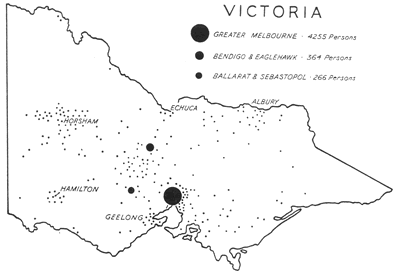
Map: Distribution of the Germans in Victoria around 1900 (from: Borrie,
Wilfried. 1954. Italians and Germans in Australia / A Study
of Assimiliation. F.W. Cheshire, Melbourne).
See:
Lodewyckx, Prof. Dr. A. 1932. Die Deutschen
in Australien. Ausland und Heimat Verlagsaktiengesellschaft, Stuttgart.
Darragh, Thomas & Robert Wuchatsch. 1999. From
Hamburg to Hobson's Bay: German emigration to Port Phillip (Australia Felix)
1848-51. Wendish Heritage Society, Heidelberg (Victoria).
Meyer, Charles. 1982. "The Germans in Victoria
(1849-1900)". In: Journal of the Royal Australian Historical Society,
Vol.68, June 1982, pp18-36, Sydney.
| Top | Back
| Chronology | Issues
| Students | Site Map |
auf Deutsch |
| Primary Sources (in German) | Bibliography
| Search |
German Australia © D. Nutting 2001